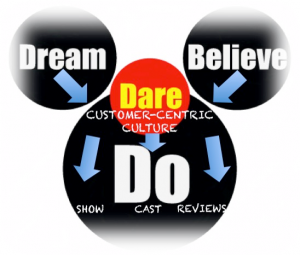The Customer-Centric Culture Model

FACTORS TO CONSIDER BEFORE EMBARKING UPON A JOURNEY TO PRODUCE A CUSTOMER-CENTRIC CULTURE
Readiness of the organization. The organization must be ready and capable of accepting a new set of values. If there is upheaval in the organization due to mergers or acquisitions, major product changes, significant stock devaluations or pending bankruptcy, or other serious issues, the time may not be right to begin a cultural transformation.
Steering Team. Leadership from all areas of the organization will be represented on the Steering Team. They will be responsible for reinforcing the new values and implementation efforts at every opportunity.
Customer-centric culture champion. One staff member will be the go-to person who is in charge of managing the various phases and details of the implementation effort. This can be an employee at any level of the organization and someone who exhibits great facilitation and organizational skills.
Training. Top leaders must commit to immersing each and every employee in a multi-day customer-centric culture experience.
Resources. The funding and employee time commitment needed for the implementation effort must be available.
Communication. A formal communication plan must be drafted to reinforce the customer-centric culture implementation.
Once these six requirements are in place, an implementation for establishing a customer-centric culture can begin.
PLANNING – LEADERSHIP WEEK
The first step of the journey in the Implementation is called Leadership Week. Leaders from all levels of the organization will be immersed in Creating a Customer-Centric Culture: The Disney Way and will use the Customer-Centric Culture Model to develop their own unique culture.
The Model depicts the organization’s principles of Dream (including a Vision, Mission, or Story) and Believe (Values and Codes of Conduct). These are the Inputs or drivers to produce the culture. The Dare principle represents the “leap of faith” required for employees to embrace the organization’s Story and Values. The Do principle brings the Dream to reality. The Outputs of “Show”, “Reviews”, “Cast” are as explained as follows: each and every department/team of an organization will produce their own unique “Show”; a “Review” process is established to track and measure results, and lastly, “Cast” represents the hiring process, orientation, coaching and feedback and development planning.
In the “Dream” section of The Disney Way 3rd edition, we described the power of an organization’s story. Leaders must be able to communicate a compelling story that can both explain the need for a culture change and motivate employees to adopt new values and behaviors. After Leadership Week concludes, employees will participate in a multi-day Disney Way “experience” during which they will be learning, and be invited to embrace a new set of values and codes of conduct. Through a series of highly engaging exercises, discussions and presentations, they begin to realize that some of their old values will no longer be applicable in the new culture. They will participate in storyboarding to identify key issues and ideas for improvement that will be further evaluated by a cross-functional customer service team.
Becoming customer-centric is not an activity to be “checked off” during an annual strategic planning session. Top management must drive an organization-wide customer-centric initiative, while also inspiring their frontline leaders to take ownership in its development and results.
